Slices/ 09
The ultimate flouringredient guide



Italy is beautiful, isn't it? Italy with a thousand excellences, of course! Italy, where food is considered not an accessory for its survival but a distinctive trait of its cultural identity. But also Italy which - to paraphrase Churchill - thinks of wars as if they were football matches and experiences football matches as if they were wars. Italy which, by way of example, clashes over pizza more than it does over politics. Is that good, you say? Maybe! Since I have been dealing with gastronomic culture and territorial enhancement, many times I have found myself dealing with divisive words, which have become fashionable and then set aside after they have been emptied of all meaning. In the beginning, it was the case of "gourmet", a lucky term coined by a privileged pizza observatory made up of a mill (and
Pizza lexicon.
BY ANTONIO PUZZI
of the word "contemporary" has been celebrated. A lot people have asked me recently in social circles: "What is contemporary pizza for you?". I will not hide from you that my answer is rather obvious: it is what is being done now. Yes, because the contemporaneity of pizza has always consisted in its ability to update the message according to the languages of its time. This is the case for those looking for products and flours and for those studying techniques and tools. Does this mean that traditional Neapolitan pizza is not contemporary? Far from it! It knows how to speak to today's world, for both the charm of tradition and the ability to know how to create a product that is closer to contemporary taste. Heresy? Blasphemy? And why? Read the following pages with us and you will discover how much beauty there is in a dish that is still our flag today. Also, thanks to you, who make it a work of art, hoisting the flag of our wonderful country into the four corners of the world.

4 EDITORIAL
p.6
Pizza is Neapolitan only if TSG…
“MA OVERO FAJE?”(ARE YOU JOKING? IN NEAPOLITAN ED.)
—
BY ANTONIO PUZZI
p.12
Cooking.
REFLECTIONS FOR AN ANTHROPOLOGICAL HISTORY OF PIZZA
—
BY ANTONIO PUZZI
p.22
What are you cooking on my pizza?
—
BY GIUSY FERRAINA
p.28
We defend real food, WITH OUR TEETH
—
BY BARBARA NAPPINI
p.35
Tuna and salmon: IS SUSTAINABILITY POSSIBLE?
—
BY CATERINA VIANELLO
p.40
Nettle:
SPRING THAT STINGS
—
BY CATERINA VIANELLO
p.44
"Where are you off to without your pineapple?"
—
BY THE EDITORIAL STAFF
p.48
Sausage and salami: HISTORY AND USE IN COOKING
—
BY CATERINA VIANELLO
ARTICLES
p.18
Raw and cooked: MEASURING QUANTITIES
—
BY MARISA CAMMARANO
p.32
The future of raw Extra Virgin Olive Oil
—
BY ALFONSO DEL FORNO
RECIPES
p.52
Pizza chef from the countryside, pizza chef of change
—
BY GIUSY FERRAINA
p.59
p.60
Giulia Vicini
The pizza chef of the world to come
—
BY GIUSY FERRAINA
p.65 Cristian Tolu
SUMMARY
SLICES/09 THE ULTIMATE FLOUR-INGREDIENT GUIDE
1. Pizza is Neapolitan only if TSG…“MA OVERO FAJE?”(Are you joking? in Neapolitan ed.)
BY ANTONIO PUZZI
said a very young and beautiful Valeria Moriconi, playing Pupella in the film adaptation of Miseria e nobiltà of 1954, the film in which the unbeatable king of laughter, Totò, was consecrated to the role of Felice Sciosciammocca. The subject of the discussion was a "pizzella" received as a gift from Peppiniello, born Franco Melidoni, which the boy had unfortunately put in his pocket together with a letter that his father, Totò, had asked him to deliver to the "knight", the person who would have helped them fight poverty and that instead had refused the letter, because it was greasy with pizza oil. That "pizzella", even if rigorously folded over, has been known since 5 February 2010 as Pizza Napoletana TSG, Traditional Specialty Guaranteed, of the European Union. And before? It was simply “pizzella” or “pizza”.
And this was precisely one of the reasons why the reservation of the name was not requested at the time. In practice, a regulation was being codified, born from the wisdom and daily practice of about three centuries but it was well understood that this was only one of the possible ways in which pizza expressed itself in "its" Naples: a living product, like the dough and therefore in continuous evolution, a product that is impossible to confine to the chains of a legislation.

6
“PIZZA, PIZZA, PIZZA… WE KEEP TALKING HERE AND NEVER EAT”
According to the codified recipe, "Pizza Napoletana TSG looks like a rounded baked product, with a variable diameter that must not exceed 35 cm (13 ¾ in), with a raised edge (cornice) and with the central part covered by the topping".
And the following is the explanation to prepare the dough: “Pour one litre (35.2 UK fl oz, 33.8 US fl oz) of water into the mixer, add and dissolve between 50 and 55g (1.76 – 1.94 oz) of sea salt, 10% of the total quantity of flour is added, then 3 g (0.11 oz) of brewer's yeast is dissolved, start the mixer and gradually add 1.8 kg (63 ½ oz) of W 220-380 flour until the desired consistency is reached, known as the dough point. This operation must take 10 minutes. The dough must be worked in the mixer preferably with a fork for 20 minutes at low speed until a single compact mass is obtained”.
THE ULTIMATE
SLICES/09
FLOUR-INGREDIENT GUIDE
1. PIZZA IS NEAPOLITAN ONLY IF TSG... "MA OVERO FAJE?"
7
SO NO SOURDOUGH, LOOK OUT! But let's get to the processing times: “The dough, once removed from the mixer, is placed on a work table in the pizzeria where it is left to rest for 2 hours, covered with a damp cloth, so that the surface doesn’t harden, forming a sort of crust caused by by the evaporation of the humidity released by the mixture itself. After the 2 hours of leavening, the loaf is formed and this must be done by the pizza chef exclusively by hand. […] Once the loaves (staglio) have been formed, a second leavening takes place in food boxes, lasting from 4 to 6 hours. This mixture, stored at room temperature, is ready to be used within the following 6 hours"
BY
ANTONIO PUZZI Slices/
8
8 hours of leavening and consumption within the following 6 hours, therefore! I challenge anyone to find a pizza chef who today even remotely recognizes himself in this description.
Is it a wrong regulation? Absolutely not, but pizza has evolved in the meantime and above all the attitudes of the two associations that best represent the category have changed: the Associazione Verace Pizza Napoletana and the Associazione Pizzaiuoli Napoletani. In particular, the Disciplinary of the Associazione Verace Pizza Napoletana has changed (recently), and for a couple of years it has recognized the use of sourdough and also the use of coarser flours.
However, the turning point came with the request to change the protection regime from "without reservation of the name" to "with reservation of the name" in order to safeguard the registration of the product in question, after the abolishment of the registration of agricultural and food products as TSG without reservation of use of the name. In 2015, the Ministry of Agricultural Policies was practically "forced" to include the protection of the name in the Official Gazette of 25 November. This choice was solicited by the Neapolitan Pizzaiuoli Association – who feared the removal of the TSG recognition - (according to what Ettore Rosati, Director of the Qualivita Foundation, declared to Francesco Seminara in an interview for La Repubblica). Yet today they are the first to take sides against it: Sergio Miccù was president then and still is today. No one in Europe has opposed the public request, leaving the go-ahead for registration with reservation of the name Pizza Napoletana TSG.

9
SLICES/09 THE ULTIMATE FLOUR-INGREDIENT GUIDE 1.
IF TSG...
PIZZA IS NEAPOLITAN ONLY
"MA OVERO FAJE?"
Slices/
BY ANTONIO PUZZI
This is natural because pizza, as we said in the incipit of this article, is like the dough that characterises it; a living, constantly evolving product and the rules that try to harness it can only be disregarded in a short time. And this is the reason why the choice in 2010 not to request the "reservation of the name" was very wise. But what does it mean? It means that one could freely choose to certify one's own Marinara and Margherita as TSG but also to call "Neapolitan pizza" that which did not correspond to the specification.
To tell the truth, this news - still awaited, although not announced - has not aroused much attention in the trade associations or even among insiders. Even the great food and wine journalists speak little while Coldiretti even rejoices, stating in a note: The new regulation came into force on 18th December and, again according to Coldiretti, «finally secures the international fame of a symbolic Made in Italy dish».
"IF THE PIZZA NAPOLETANA DOES NOT HAVE ALL THESE CHARACTERISTICS, IT WILL CONSTITUTE AN OFFENSE ON WHICH THE CENTRAL INSPECTORATE FOR THE PROTECTION OF QUALITY AND THE REPRESSION OF FRAUDS (ICQRF) IS ALREADY WORKING TO UPDATE THE RELATIVE SANCTIONING PROVISIONS CONCERNING THE PROTECTION OF GEOGRAPHICAL INDICATIONS AND DESIGNATIONS OF ORIGIN OF AGRICULTURAL AND FOOD PRODUCTS".

10

Cooking. Reflections for an anthropological history of pizza
COOKING IS ONE OF MAN'S POSSIBLE CULTURAL RESPONSES TO THE NEED FOR NOURISHMENT.
An English study carried out between 2013 and 2015 reveals that, if properly educated, even chimpanzees are able to wait for the food to be "cooked", but these are obviously environmental conditions that are difficult to replicate in nature and, above all, a practice which consists in reheating or cooking at a “low temperature”. Over time, however, man has developed increasingly complex food cooking systems, trying to adapt the desire for healthy and tasty food to his own conditions.

BY ANTONIO PUZZI Slices/ 12
CLAUDE LEVI-STRAUSS WAS THE FIRST TO EMPHASIZE "COOKING AS CULTURE"
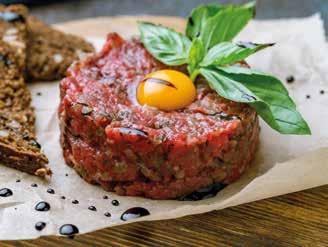
the anthropologist who, perhaps more than any other, has influenced the way of seeing, understanding and analysing contemporary Western society starting from those populations that many considered (erroneously) "primitive" prior to his studies. Commenting on one of the most important works by Levi-Strauss (The Raw and the Cooked), one of his most passionate scholars (and friends), Marino Niola wrote in 2016 in La Repubblica: "In the beginning of everything is fire, incipit of every mythological epic, origin of every metamorphosis. Because, by allowing food to be cooked, it takes humanity out of the state of nature and into culture. That's cooking. As if to say that at the same moment in which men begin to produce fire, fire begins to produce men”. It would therefore be fire that transforms us "from animals to Gods" (to quote Yuval Noah Harari). And it is no coincidence that one of the most famous myths of antiquity attributes to an alterHercules, Prometheus, the ascent to heaven in search of the wisdom of the Gods not with a fruit (as in Genesis) but through the "theft of fire". However, Prometheus is not alone: in fact, there are numerous societies scattered across the four corners of the planet that tell similar cosmogonies (stories about the origin of the known world) where fire is at the center of the development of knowledge. Of course, not all the myths concerning fire speak of food: fire is in fact essential for heating, for keeping predatory animals away but also for cooking. However, it is the latter that "creates" culture more than any other. As beautifully summed up by Andrea Camilleri:
“When Eve took the apple from the tree and offered it to Adam, she created culture. The first mother who weaned her child on berries that she had discovered to be edible created culture. The first man who pointed a stone to hunt, and therefore to eat, created culture. The first man who engraved a buffalo on the rock to communicate that there was hunting there, and therefore food, created culture. The first man who realized that animal meat was tasty created culture. The first man who poked two holes in a dinosaur egg, drank it and advised his clan to do the same, created culture. The first man who made a spark by rubbing two sticks with which he lit a fire, with which he cooked the meat of buffaloes, created culture. The first man who, angry about the buffalo that had just escaped from him, crushed some olives with his hands and realized that they could be a good condiment for buffalo meat, created culture. The first man who, after an indigestion of buffalo meat, proceeded to warn others that one shouldn't eat too much of it, created culture. The first African and the first Indo-European who exchanged their different foods created culture”.
SLICES/09 COOKING. REFLECTIONS FOR AN ANTHROPOLOGICAL HISTORY OF PIZZA THE ULTIMATE FLOUR-INGREDIENT GUIDE 13
THE CULINARY TRIANGLE

But which type of cooking is the most culturally advanced? That with the use of containers, that on stone (now soapstone) or the geothermal type, that exploits the natural heat of the subsoil? It is difficult to say but we can certainly agree that foods can present themselves to man in three conditions: raw, cooked or putrid. These categories that Levi-Strauss identifies as "universal" (because they are present in all societies) each represent an aspect of our community life: the raw constitutes the natural aspect of food, the cooked is the cultural transformation of the raw while the putrid is its natural transformation. This is what the author calls the "culinary triangle" on which we have the opposites of processed and unprocessed food on one side and that between culture and nature on the other. According to Lévi-Strauss, nothing is simply "cooked", but every "cooked" has its own way; likewise, there is no pure "raw" food: in fact, only certain foods can be eaten raw, but on the condition that they are first washed, peeled, cut and in many cases also seasoned. In practice "assimilated", or made similar to what for us is "good for thought"
even before eating. It is no coincidence that even the societies that practiced cannibalism, before having the ritual lunch with the defeated enemy, disguised them as a member of their own community, precisely in order to "assimilate" them. As the anthropologist Remotti writes, this means that "otherness should not be eaten raw" or rather that everything that enters us must in some way "resemble us", that is to say be attributable to something already known, in terms of shape, taste or texture. Just as happens in the weaning of children which takes place gradually and not by shock.

BY ANTONIO PUZZI
/
Slices
Arrosto Affumicato aria acqua (-) (-) (+) (+) Bollito 14
Crudo Cotto Putrido
THE PIZZA IN HOME AND PUBLIC COOKING
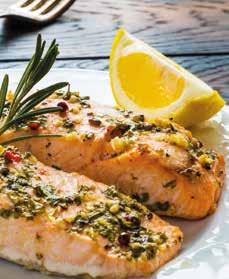
Within the culinary triangle theorized by LeviStrauss, however, there are also differences between the types of cooking, in particular between roasted and boiled meat, the two most common cooking methods from which techniques and tools that have continued to the present day. Boiled meat is in fact cooked inside a container with different types of liquids, roasted is cooked outside the container, almost always in direct contact with the fire.
FOR THIS REASON, LEVI-STRAUSS
DEFINES THE BOILED MEAT TECHNIQUE AS AN "ENDO-COOKING" FOR DOMESTIC USE AND INTENDED FOR SMALL CLOSED, FAMILY GROUPS, WHILE THE ROAST IS CALLED "EXO-COOKING", THAT IS, COOKING MADE FOR GUESTS.

It is no coincidence that pizza supports this propensity in an almost didactic way: the "Neapolitan" pizza (as well as the "classical") is in fact cooked directly on the stone in "almost direct" contact with the fire and the ingredients are - according to tradition - placed on the pizza almost always raw and cooked with it, without preliminary treatments. The pizza in the wheel or pan is instead a direct descendant of that pizza that was cooked together with bread and which was a delicacy to bring to the table to delight the family. However, it requires one more step: a tool, a container on which to cook it.
Today, the constant search for innovation has brought the latter to a place of honour on the table, but the goal often declared by pizza makers is precisely that of taking up a family tradition, which confirms what has just been written. But what about the cooking of the ingredients? As mentioned a few lines above, originally it was not customary to place precooked products on the pizza, let alone add ingredients after cooking the dough disc. Today, however, contemporary pizza provides more and more preparations cooked separately, some of which require placing on the pizza after it has been cooked, exactly as happened on the mensae, the mixtures of water and flour which in ancient Rome served as cooking and serving dishes. Nothing new under the sun, therefore, but only a practice that reinvigorates the link with the tradition of a "legendary recipe".
SLICES/09 COOKING. REFLECTIONS FOR AN ANTHROPOLOGICAL HISTORY OF PIZZA THE ULTIMATE FLOUR-INGREDIENT GUIDE 15
CHEAP OR EXPENSIVE?
Before coming to conclusions, allow me to share a curios fact with you: if you love to place boiled meat on your pizza, i.e. meat cooked in a container (from the classic pot to professional trays up to the cooking boxes born during the First World War and back in vogue), you're reconnecting to the idea of home economics; if you prefer to use the roast, you are closer to the idea of prodigality. As stated in Taccuini Gastrosofici, the digital encyclopaedia of food cultures and policies accessible for free online and directed by Alex Revelli Sorini and Susanna Cutini for the San Raffaele University of Rome and the Italian Academy of Cuisine:
“Roast and boiled meat represent two methods of preparation that allow the meat to preserve its nutritional juices differently: boiled meat preserves them in the sauce created after cooking in water; the roast, based on the type of preparation, loses them partially”, which is why “one is popular, the other aristocratic”. For example, it is said that Charlemagne was particularly fond of roasts, ça va sans dire. As food historian Massimo Montanari argues: "eating behaviors are the result not only of rationally pursued economic, nutritional and health assessments, but also of choices linked to the imagination and symbols of which we are bearers and in some way prisoners". Meat cooked at a low temperature and then subjected to the Maillard reaction before being served presents a few more difficulties: does it belong to the group that practices home economics or the
big spenders? But this is another story, it is up to us to interpret it according to the patterns we know. Marino Niola (who writes about it in the aforementioned article for La Repubblica) explains: "Raw and cooked, roasted and boiled, putrid and smoked, dried and marinated become the vowels and consonants of a universal grammar that serves to articulate words but also habits, customs, ways of living, thinking, feeling. In short, the kitchen is humanity's true start-up, the big bang from which civilizations are born”. I close with a suggestion. If you want to know everythingabsolutely everything - about the history and techniques of cooking, I recommend reading Cuocere by Eugenio Signoroni, a very current manual written by a true enthusiast.

/ 16
BY ANTONIO PUZZI Slices






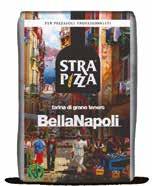 BY MARISA CAMMARANO
BY MARISA CAMMARANO
Very often, the weight of food changes after cooking because, during this time, its structure varies. The final product also differs according to the cooking method. When boiling, food tends to double in weight, because it comes into contact with water and incorporates it. On the contrary, if you roast food, the water is removed and the weight can decrease. Understanding how the conversion of the weight of cooked to raw foods works can also and above all be useful both for calculating the yield in the preparation of a pizza or dish and for calculating the food cost of the dish itself. In order not to make mistakes, it is possible to bear in mind precise conversions, to know how the weight of the food changes from cooked to raw.
Raw and cooked:

The weight of a food therefore varies according to 2 factors:
INTRINSIC COMPOSITION influenced by "waste" (e.g. peel, stone) and by the quantity of water and fibres; COOKING METHOD (boiling, frying, pan cooking, etc.).
Each food varies its weight during cooking in a different way. Let's take carrots and spinach for example: they are both vegetables, but the former are more fibrous and hydrated. Same food group but different intrinsic composition, and, consequently, different post-cooking weight variation. Foods belonging to the same food group vary in weight fairly evenly.
/
Slices
18
In particular, we know that:
• Pasta and grain cereals increase their weight by 2-2.5 times;
• Fresh egg pasta increases its weight by 3 times;
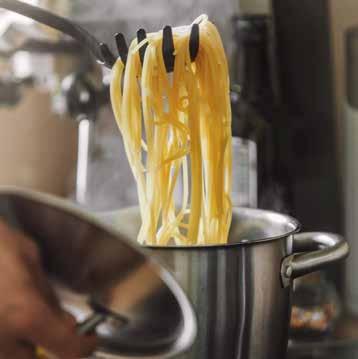
• Meat and fish, by losing water, tend to decrease by up to 35%;
• Cooked legumes triple their weight compared to raw ones;
• Except for a few, such as savoy cabbage and cabbage, all vegetables lose between 10 and 20% of their weight. This can help us understand the raw weight very quickly. Indeed, to convert the weight of a cooked food, it is necessary to divide its weight by its conversion factor.
PASTA When cooked, pasta and rice weigh 100-120% more. For 100 g of raw short pasta there will be 202 g of cooked pasta, for 100 g of raw long pasta there will be 244 g of cooked, for 100 g of raw rice there will be 260 g of cooked rice; 100 g of fresh egg pasta correspond to 290-300 g of cooked pasta.
MEAT The rules to follow for weighing cooked and raw foods vary greatly when it comes to meat, also based on the size of the piece. If boiled meat is prepared, the food can lose up to 30-40% and 1 kg of raw product becomes 600-700 g of cooked. If you roast meat, the variation depends on the type: 100 g of chicken or turkey becomes 90 g when cooked; 100 g of beef or pork, on the other hand, can weigh 70-75 g.
measuring quantities
The situation is different with frying: 100 g of meat, such as chicken or turkey, becomes 80-85 g, a 100 g slice of beef or pork becomes 65-75 g. So, if we want to know how many grams of raw correspond to 150 grams of cooked rice, the calculation to do will be:
150: 2.5 = 60 g → quantity of uncooked rice
SLICES/09 RAW AND COOKED THE ULTIMATE FLOUR-INGREDIENT GUIDE 19
Slices/
LEGUMES We distinguish fresh legumes which lose 15-20% in weight, because 100 g of fresh raw legumes become 80-85 g of cooked. On the contrary, dried legumes acquire 50-90% of the weight. In general, legumes such as beans and lentils go from 100 g to 240-250 g when cooked, while 100 g of raw chickpeas correspond to 280290 g of cooked ones.
FISH If boiled, fish loses 15% in weight and 100 g of product can weigh up to 85 g. With frying, it loses 35% of its weight and 100 g of raw product becomes 65 g of cooked. For molluscs, however, it is different: from 100 g it goes to 45 g. After being roasted, 200 g of raw fish weighs 140g.
VEGETABLES For vegetables it is slightly more complicated, because it depends on the conformation of the food and the amount of water and fiber contained in it. Leafy vegetables, such as spinach or chard lose 15-20% of their weight when cooked. In fact, 100 g of raw food becomes 80-85 g of cooked food. Boiled vegetables lose only 10% and 100 g of raw product becomes 90 g when cooked. With frying they lose 25-30% and 100 g of raw product becomes 70 g of the cooked one. Roasted vegetables, such as aubergines or courgettes, can lose up to 60%, so from 100 g of raw product you can reach 40 g of cooked.
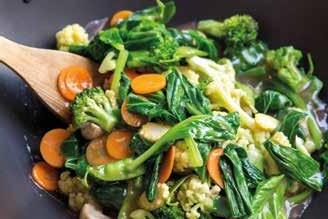 BY MARISA CAMMARANO
BY MARISA CAMMARANO
ROASTING/GRILL/OVEN
Meat (100 grams)
Adult beef, lean 54 Chicken (breast): 89
Adult beef, slice: 73 Turkey (breast): 89
Pork, slice: 75
Fresh fish (100 grams)
Garfish: 63
Sardine: 69
Eel: 72 Mackerel: 73
Gray mullet: 75 Sole: 70
Grouper: 79
Red snapper: 71
Cod: 68
Sea bass: 75
Tuna (trance): 74
Trout: 73
Frozen fish (100 grams)
Grouper: 80
Red snapper: 75
Cod: 69
Sea bass: 76
Various (100 grams)
Aubergines eggplant: 40 Peppers: 93
EGGS Changes in weight of food after being cooked also affect eggs. For example, a fried egg can lose 10% in weight and 50 g of product becomes 45 g. If you make an omelette, the weight can decrease by 1525%: with two eggs weighing 100 g you get an omelette weighing about 75-85 g. Just as the weight of cooked and raw foods changes, so does the caloric intake in relation to consumption raw or after cooking. The difference depends on how much water foods absorb: in fact, although water does not contain calories, it is able to change the caloric density of a food. And it is precisely the caloric density that determines the degree of satiety of one food compared to another so that a food that loses liquids during cooking will fill me up less than the same raw food; this is the case of fennel which, by losing liquid during cooking,
20
COOKING METHOD: BOILING
Cooked pasta (100 grams/ 3.53 oz)
Dried egg pasta: 299g / 10.55 oz
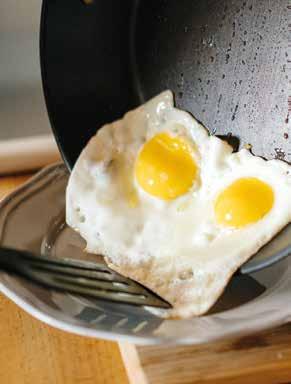
Short semolina pasta: 202g / 7.13 oz
Long semolina pasta: 244g / 8.61 oz
Polished rice: 260g /9.17 oz
Parboiled rice: 236g / 8.32 oz
Fresh tortellini: 192g / 6.77 oz
Fresh legumes (100 grams/ 3.53 oz)
Green beans: 95g / 3.35 oz
Dried legumes (100 grams/ 3.53 oz)
Lentils: 247g / 8.71 oz
contains a lower satiety index when compared with that of raw fennel. However, to understand how the weights of raw and cooked foods change, you need to follow the table with the indications of the National Research Institute for Food and Nutrition (CREA).
Broad beans: 80g / 2.82 oz
Chickpeas: 290g / 10.23 oz
Beans: 242g / 8.54 oz
Greens and vegetables (100 grams/ 3.53 oz)
Agretti: 86g / 3.03 oz
Asparagus: 96g / 3.89 oz
Chard: 86g / 3.03 oz
Broccoli per head: 96g / 3.89 oz
Turnip broccoli: 95g / 3.35 oz
Artichoke: 74g / 2.61 oz
Cardoons: 60g / 2.12 oz
Carrots: 87g / 3.07 oz
Cauliflower: 93g / 3.28 oz
Brussels sprouts: 90g / 3.17 oz
Branchy cabbage: 57g / 2.01 oz
Green cabbage: 99g / 3.49 oz
Savoy cabbage: 100 g/ 3.53 oz
Field chicory: 100 grams/ 3.53 oz
Cultivated chicory: 80g / 2.82 oz
Onions: 73g / 2.57 oz
Small onions: 78g / 2.75 oz
Fennel: 86g / 3.03 oz
Potatoes with peel: 100 g/ 3.53 oz
Peeled potatoes: 87g / 3.07 oz
Leeks: 98g / 3.45 oz
Turnips: 93g / 3.28 oz
Spinach: 84g / 2.96 oz
Jerusalem artichokes: 100 g / 3.53 oz
Courgettes / zucchini: 90g / 3.17 oz
Meat (100 grams/ 3.53 oz)
Adult beef, lean meat: 66g / 2.32 oz
Chicken (breast): 90g / 3.17 oz
Chicken (breast and leg): 76g / 2.68 oz
Turkey (breast): 98g / 3.45 oz
Turkey (leg): 70g / 2.47 oz
Fresh fish (100 grams/ 3.53 oz)
Garfish: 86g / 3.03 oz
Mullet mullet: 85g / 3 oz
Grouper: 86g / 3.03 oz
Red snapper: 85g / 3 oz
Cod: 86g / 3.03 oz
Sea bream: 86g / 3.03 oz
Mackerel: 65g / 2.29 oz
Sole: 83g / 2.93 oz
Sea bass: 86g / 3.03 oz
Tuna (slices): 80g / 2.82 oz
Frozen fish (100 grams/ 3.53 oz)
Grouper: 86g / 3.03 oz
Red snapper: 85g / 3 oz
Cod: 83g / 2.93 oz
Sea bass: 86g / 3.03 oz
SLICES/09 RAW AND COOKED THE
ULTIMATE FLOUR-INGREDIENT GUIDE
What are you cooking on my pizza?
“Pizza-top cuisine” is becoming the leitmotif of contemporary pizza; a fundamental element that blurs the line between pizzeria and restaurant. Misunderstood at the beginning, seen as an outrage to tradition and a coercion, today it is a natural path for many pizza makers who are daringly exploring with toppings, after carrying out thousands of experiments with dough in the search for the crunchy effect with honeycomb edges -. Here we are not talking about more or less complex assemblages of great raw materials - an aspect that has characterised the so-called gourmet pizza for years - but the concept is precisely that of “cooking on the pizza and for the pizza”.

BY GIUSY FERRAINA Slices/
22
▷ "Milanese" Pizza by Amalia Costantini
ON THE PIZZA AND FOR THE PIZZA”
This is quite a serious activity, which implies profound knowledge and respect for the raw materials, the cooking techniques as well as the doughs themselves, which must be perfectly combined with what will be put on top. Moreover, ‘pizza-top cuisine’ also presupposes a great deal of creativity, a profound search not only for the ingredient, but also for flavour and balance. Having started out as an experimental form, it is now an expressive requirement, a virtuous intermingling with the world of cuisine toutcourt, along with ovens, which has had the power to banish ingredients of dubious origin. It was originally called gourmet pizza and the forerunner was Simone Padoan of ‘I Tigli’ who practically rewrote the very concept of pizza. The starting point was rethinking what was put on the pizza to give it greater value and a different flavour, changing the raw materials, choosing fresh and working it directly. Padoan blazed a trail and had many followers; since then, there have been numerous experiments, including extravaganzas and masterpieces.
Pizza gastronomy finds inspiration in typical local recipes, feeds on the imagination of those pizza chefs who are ‘a little bit chef a little bit master pizza maker’, becomes seasonal and sustainable, is attentive and does not waste. Vegetables are the absolute protagonists: stewed, creamed, roasted, burnt. And then there are powders, acidities, fish and meat, raw and the various types of cooking, from low temperatures to bbq. In short, when we talk about cooking, we are really talking about fire and techniques that transform materials, creating textures and composing new flavours.
TRADITIONAL CUISINE HAS NEVER BEEN SO FASHIONABLE.
TRADITIONAL CUISINE ON PIZZA

It is easy to think of carbonara, genovese or arrabbiata when talking about cooking on pizza. Here we go further: traditional cuisine has never been as fashionable on pizza as it is now. Do you want an example? Let us serve you with one: Padoan has the polenta and creamed cod pizza among his creations; a perfect example of what we are talking about.

SLICES/09 WHAT ARE YOU COOKING ON MY PIZZA? THE ULTIMATE FLOUR-INGREDIENT GUIDE 23
“COOKING
△"Pizza Elisir del Pastore" by Luca Cornacchia
▽ Pizza "Tiana di Agnello" by Mirko Cicco
Slices/
At Dry Milano, Sirabella makes the Pizza Cassuoela Luca Cornacchia at Fermenta in Chieti highlights the Abruzzo dishes with the aim of telling the region and its products through his gourmet pizzas with real recipes. And he does so with the Shepherds’ Elixir Pizza; a Pizza with Callara Mutton, a typical marinated then slow-cooked mutton dish (up to 10 hours) in the callaro (pot hanging in the fireplace) on low heat. A dish with an intense taste that works well on pizza dough. And he is not the only one. From Fermenta we also find ‘Cif and Ciaf’, where the topping is precisely the famous dish linked to the festivities for the slaughter of pigs: a nostalgic, friendly dish, which was prepared with the cuts and the parts not used for seasoning (usually cheeks and off-cuts), quickly sautéed in a pan with oil and onion. In Catanzaro Mirko Cicco of Il Golosone puts the “Tiana di Agnello” another typical dish that is prepared on holidays in Calabrian homes, in the Roman pizza pan. The dough is seasoned with potatoes and rosemary to have all the ingredients of the classic dish and the topping is based on low-temperature cooked lamb, with creamed peas and fried artichoke. And sticking with pan pizza, Sara and Mario of Pizza Chef in Rome put “alla romana” tripe, chicken “alla cacciatora” and even meatballs on their bases. Yes, precisely those round meatballs, well cooked in the sauce and placed on the pizza. And as Mario is keen to emphasise: ‘everything in our pizzeria is properly cooked, especially the vegetable part, from the sautéed vegetables, to the cream of pumpkin, to the mushrooms sautéed and then combined with the rest of the ingredients’. In Rome, Pier Daniele Seu in his Seu Pizza Illuminati has made gourmet and cooked pizza his highest form of expression. His identity and his history live and relive in every recipe he invents for
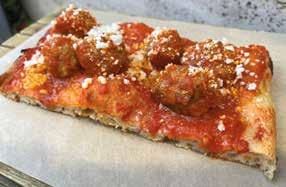 BY GIUSY FERRAINA
BY GIUSY FERRAINA
his pizzas. An example from the latest menu is the Ham, Cream and Peas, a classic dish from the 1980s with Parmesan béchamel, fiordilatte, roasted ham, pea cream, nutmeg, Parmesan cheese and wasabi pea crumble; the Valeria in Koh Phangan with fior di latte, thay marinaded chicken, soya bean sprouts, thay salted zabaglione, coconut milk and green curry, cashew nut crumble, lime juice, basil and coriander chop is also interesting. Two pizzas in which the elements combined are many, and are carefully prepared before they reach the disc of dough to create a

24
△ Meatballs Pizza by Sara and Mario of Pizza Chef
▽ "Seu Pizza Illuminati" by Pier Daniele Seu
final result. Seu has no doubts about the importance of cuisine in a pizzeria. He believes that the things that differentiate the creative pizza chef from the rest are the toppings, much more than the dough. This is where the construction of identity is defined. A statement that finds full confirmation in his personal journey: from the beginning to the present day, cuisine is increasingly the protagonist of his dough discs and also in an original way; there are no imitations, only ad hoc recipes. “It all comes from my memories, from the dishes I ate as a child and from many trips, a great source of inspiration and knowledge. In the smells and flavours of new products, in the dishes tasted in foreign, typically local and award-winning restaurants, I always look for intuition, the element of taste to then be transferred to my pizza” – explains the Roman pizza chef. And just reading his complete menu, you understand the level he is on now. Let’s go to Mater in Fiano Romano (Rome). Leafing through the menu, you will find many proposals, all of which are seasonal and interesting, such as the Milanese with veal stew, potato purée

and saffron cream or the pizza with onion cream, creamed cod and kale chips (taken to Identità Golose), the one with wild boar ragout and purple potato cream and the vegan one with beets, white cauliflower cream, cabbage and bread crumble. “I have always loved cooking and when I decided to open Mater I was afraid of turning it into a restaurant and I opted for a pizzeria (later finding twice as many problems), but with the clear idea that I could do what I usually did with pizza making, that is, creating dishes”. This is how Amalia Costantini, owner of Mater, begins. For her, pizza is cuisine: it must be like this if we want a unique, personal product. Her pizzas combine sourdough and dough, the careful research of ingredients, possibly organic and local, and worked in the restaurant. There

SLICES/09 THE ULTIMATE FLOUR-INGREDIENT GUIDE WHAT ARE YOU COOKING ON MY PIZZA? 25
△ Pizza by Valeria a Koh Phangan
▽ Pizza by Amalia Costantini
are deliberately few assembled pizzas: here cooking and creativity have taken over. There is a predisposition towards vegetables proposed in different shapes and textures, used as a base, as an amalgam or as a crunchy touch. There is also a lot of colour, because as Amalia says: “my pizzas must also be beautiful and not just tasty”.
SEA FOOD ON PIZZA

Let’s now go to Clementina in Fiumicino (Rome), the pizzeria of Luca Pezzetta, who delights with his virtuous raw and cooked seafood dishes. His slices of pan-fried or Roman pan pizza are garnished with shellfish, larded and bbq-seared prawns, accompanied by vegetable creams or rigorously homemade mayonnaise. His dough, rolled out with a rolling pin, does not betray expectations. Clementina actually disguises itself as a pizzeria but contains the essence of a refined seafood cuisine. Between the dryaging of fish, marinades, tuna and amberjack seasoning, the work done here is haute
26
by Luca Pezzetta
cuisine, not to mention the choice to work only with local fish to try to be as sustainable as possible. Two pizzas worth mentioning which are exemplary of our theme: the “Tripe, Belly and Shellfish”, topped with tripe, pork belly, raw prawns, PDO Roman pecorino cheese, curled celery and tomato and then there is the colourful “Capricciosa di mare”, reinterpretation of a “pizzeria classic”, which reworks all the ingredients transforming them into homemade tuna ham, mullet roe, red and yellow datterino tomato stew, mozzarella strips and ground olives and artichoke petals “alla giudia”. And we can safely say that it leaves no room for “gustatory or emotional” doubt.
ECCENTRIC OR EXOTIC CUISINE.
It comes from Calabria and is called Coccodrillo in Sila. The architect is Roberto Davanzo of Bob Alchimia a Spicchi in Montepaone (Catanzaro) who, in the last

BY
FERRAINA
GIUSY
Slices/
△ "Pizza Tripe, Belly and Shellfish"
▽ "Coccodrillo in Sila" by Roberto Davanzo
two years, has been making a lot of noise and who, with his commitment to doughs and toppings, has brought a new vision of pizza to the south. In this case we have a “Focaccia with potatoes from Sila with crocodile “alla cacciatora”, red pepper with vanilla, ash”. As he himself tells us: “A few months ago a supplier friend offered me this meat and, curious, I decided to try it. At the first taste I immediately thought of chicken and automatically of the chicken 'alla cacciatora' with potatoes that I had eaten a few days earlier in a restaurant in Sila. The scent of the embers led me to create a fake ash, while to make the filling softer without affecting but enhancing the crocodile that is the protagonist of the dish, I created a red pepper and vanilla sauce, one of my favorite combinations. We included the Sila potato in our focaccia, which is fragrant and soft on top while the base is crispy like chips”.
BUT THERE IS ALSO COOKING INSIDE PIZZA
we can only conclude with cooking “inside” pizza. And here the absolute symbol is the Trapizzino, the brilliant work of Stefano Callegari who made his conceptual revolution of Roman pizza in the binomial pizzacuisine. The trapizzino is grandma’s homemade Roman cooking, inside a white pizza. To be exact, it is an open triangle of white pizza containing meatballs, oxtail, offal and artichokes, tripe, chicken with peppers and “picchiapò”, which has become a registered trademark, also successfully released from Rome and exported from Milan to New York. A tasty game, thought of as the take-away that has conquered the food guides.
 ▷ "Trapizzino" by Stefano Callegari
▷ "Trapizzino" by Stefano Callegari
SLICES/09 THE ULTIMATE FLOUR-INGREDIENT GUIDE WHAT ARE YOU COOKING ON MY PIZZA? 27
Slices/
We defend real food, with our teeth*
The concept of real food now has a specific denomination: "real food", a food current that discovers how important it is to eat whole, seasonal and local, delicious and identifying foods and as little processed as possible. Good clean and fair, in short. And yet, alongside this widespread awareness, we continue to observe an imposing pressure from certain companies with their "marketing armies", to take the trivialization of our food to extremes and its enormous cultural and ecosystemic impact: in the USA, synthetic food has already received an initial approval from the Food and Drug Administration for placing on the market, and in general a narrative is proposed according to which this is "the food of the future", on a par with insects as a new food
BY BARBARA NAPPINI Slow Food Italia President www.slowfood.it

frontier and food obtained from out of the ground plants: the so-called hydroponic or “vertical” cultivation. Behind synthetic food, behind above-ground agriculture and insect meal, we often know that there are big food multinationals (such as Cargill, Tyson Foods, and Nestlé, some of which are leaders in the industrial zootechnical sector) and those investment funds that are not motivated by the desire to build a fairer food system, to defeat hunger, to protect biodiversity and ecosystems, or - as we are often told - to eliminate animal suffering. Indeed, in some cases, they are the same subjects who promoted the "Green Revolution" in the 1970s: that process of change which, through powerful mechanisation, the use of synthetic chemistry and modified seeds, should have feed the

28 *
this article is a condensed version of the article published in the April 2023 issue of Pizza e Pasta Italiana
entire world population. A political objective tragically missed: we know that today almost a billion people on the planet do not have regular access to food, even though the planet produces much more food than it needs.

We need to produce (and distribute) better, not more. Yet, an important study published in the prestigious medical journal "The Lancet" has shown that if we redirected diets and production systems in a sustainable direction, there would already be enough food to feed over 10 billion people. In addition, we could reduce the number of deaths from eating-disorder-related diseases by more than 20%, equivalent to approximately 11 million human lives per

year. We cannot repeat the same mistakes as the past, starting from a partial analysis and arriving at an answer that is always and only the industrial technological one, which is also partial. "Slow Food defends real food with its teeth": because for decades we have been restoring value to food which then simply "becomes us". Isn't it perhaps important to choose the quality of what we transform into energy, which allows us to function and to be us? It is said: "we are
what we eat" - and it is true -, but the opposite is also true: we eat as we are. Consciously determining what I buy, where I buy it, how long and how I keep it, how I treat it and how I transform it, should be our daily priority because it is a form of respect for ourselves and care for our loved ones but also a gesture that implies interest in the environment and for others. If our living conditions do not allow us to treat our diet as a priority, perhaps we should humbly and deeply reflect on the type of life we are leading and on the type of society that produces these existential conditions. We cannot reduce these issues to polarized positions but we can seize the opportunity to deepen them, understand them, and develop a critical thought in order to then go, both individually and collectively, in the most equitable, right and sensible direction. The author of this article is an incurable optimist: certain that human beings have many resources to draw on if only we abandon nihilism and a certain almost cynical disillusionment, to embrace the joy of living by determining our daily priorities, becoming agents of change, builders of meaning and interpreting the path towards a better future, also starting from food.
29
SLICES/09 WE DEFEND REAL FOOD THE ULTIMATE FLOUR-INGREDIENT GUIDE



The future of raw Extra Virgin Olive Oil

Extra virgin olive oil is one of the most important resources of the Italian agri-food scene, with increasing attention being paid to the production of this green gold. The richness of this product lies in the diversity of crops distributed over a large part of the national territory, with excellences that are present not only in southern Italy, where the climatic conditions favour the cultivation of the olive tree, but also in other regions. The strong characterization of extra virgin olive oil is the distinctive value of the biodiversity of this product, which increasingly plays a leading role in the kitchen. In fact, if oil was seen as a condiment or as a cooking tool in the past, today we cannot ignore its use as an ingredient in the preparation of dishes, using it above all raw, to make the most of its organoleptic qualities. This type of approach emerged in the Preview of the PDO extra virgin olive oil of Umbria, which was held in Todi (Perugia) on 6 and 7 February 2023. The PDO Preview, an event of the Strada dell'olio PDO Extra virgin olive oil Association Umbria,
created in collaboration with all the players in the Umbrian olive sector, starting with the Umbria Region, the Chamber of Commerce of Umbria, Promocamera Umbria, Sviluppumbria, the Umbrian Agri-food Technology Park 3A-PTA, the Municipality of Todi, the Ciuffelli Agricultural Institute – Einaudi di Todi, Strada dei Vini del Cantico and Umbrian trade associations, saw the participation of journalists from the main national newspapers in the food and
BY ALFONSO DEL FORNO
32
wine and tourism sectors, foreign operators selected by the Umbria Chamber of Commerce, Umbrian chefs from the Evo Ambassador circuit, food and wine experts and industry professionals. The splendid frescoed room of Todi’s Pinacoteca Museum was the setting for the panel test, a great tasting session of Umbrian PDO extra virgin olive oil led by Angela Canale, head of the panel of the "Oro Verde dell'Umbria" regional award. Five oils belonging to the five sub-areas of the Umbria PDO were tasted there: Colli Martani PDO, Colli del Trasimeno PDO, Colli Assisi– Spoleto PDO, Colli Orvietani PDO and Colli Amerini PDO. The characteristics of the oils tasted highlighted the richness of a territory like Umbria which, despite not having the ideal cli matic conditions for the cultivation of olive trees, expresses a variety of very different oils, with very interesting sensory markers. Among the Umbrian cultivars tasted there is the San Felice, present on the Colli Martani, which characterises the oil with the notes of the artichoke leaf on the nose while the taste has an intense bitterness that alternates with an interesting but not

prevalent spiciness. The slight final astringency is reminiscent of artichoke leaves. The Dolce Agogia dei Colli del Trasimeno cultivar, which is very different, is characterised by a general sweet tendency, which leaves room for a slight spiciness that can only be perceived in the throat. Another native cultivar is the Moraiolo, which is widespread on the Assisi - Spoleto hills and gives the oil a sweet introduction which is followed by a very present and persistent spiciness. Leccino is a cultivar present on the Colli Orvietani, whose oil is very complex and intense, with a gustatory dynamism that is unequaled in other cultivars. Bitterness and spiciness chase each other on the taste buds, creating a unique complexity. The last Umbrian cultivar worthy of note is the Rajo, typical of the Amerini hills, with sweet and bitter notes that balance each other while tasting, with hints of spicy notes reminiscent of black pepper. This sensory journey among PDO Umbria oils is just one of the virtuous examples of how you can count on the fantastic Italian oils to characterise its cuisine, considering the oil as an ingredient of a dish, capable of enhancing its structure and taste, above all when used raw.
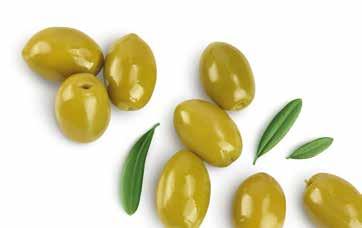
THE ULTIMATE FLOUR-INGREDIENT GUIDE SLICES/09 EXTRA VIRGIN OLIVE OIL
33




Tuna and salmon: is sustainability possible?

The concept of sustainability has now become part of not only the daily lexicon but also of our life behaviours. Since 1992, the year in which it became the new development paradigm with the UN Conference on the environment and development, much has been achieved and today, to be an active and responsible consumer, it is vital to pay attention to the sustainability of the supply chain of all foods that arrive on our tables. Attention to the environment, the well-being of animals and people during the entire production process and personal well-being are now inseparable elements. Tuna and salmon are a significant example of the most consumed products that represent privileged observation points regarding the sustainability of the supply chain. Let's try to understand more.
TUNA
The global tuna market is worth more than $42 billion a year, for a total of 6 million tonnes (6.6 US tons) of fish and more than 6 million people employed in the industry in the Asia-Pacific region alone. Tuna is in


35
THE ULTIMATE FLOUR-INGREDIENT GUIDE SLICES/09 TUNA AND SALMON
fact the most consumed fish by the world population: in fact, other than its nutritional value are its affordability and its ease of marketing, conservation and consumption (the cans) that represent the discriminating elements of its popularity. In Italy, the production of canned tuna has a market value of 1.4 billion euros for a consumption of 2.5 kg (5 ½ lbs) per capita. However, tuna is also a market that shows the most critical points in terms of sustainability: in the last 60 years its catch has increased by as much as 1000% (Source: Fisheries Research), with devastating consequences on the species and on the marine ecosystem: it is no coincidence that the International Union for Nature Conservation has classified tuna as a "species in danger of extinction". The main problems associated with tuna production are related to fishing and farming. In fact, to speed up and maximise their capture, large "trawl nets" are used, which collect indiscriminately everything they find, thus giving rise to bycatch, i.e. the accidental capture of
BY CATERINA VIANELLO
other marine species, often not suitable for trade, which are then thrown back at sea, in most cases already dead. The consequences are impactful, undermining both the extinction of the fish fauna (including that of tuna obviously: the case of bluefin tuna is emblematic), and the health of the seabed and of the entire marine biodiversity.

A further cause of impoverishment of the seas is the use of longlines and Fads (fish aggregation devices), floating structures which, thanks to shapes positioned underwater, attract tuna and other marine animals which are then captured with purse seiners. Intensive farming represents a further problem: the growing demand for tuna has influenced the increasingly massive use of fish farms. Forced into "cages", in overcrowded conditions, force-fed (with consequences on the production of a large amount of excrements) the tunas are also given antibiotics and medicines, so that epidemics or attacks of lice do not occur. Similar conditions are deleterious, transforming tuna into a fish that is certainly not healthy and nutritious.
On top of this are the questions of marine health, illegal fishing activity, failure to comply with the quota system, aimed at regulating the amount of catch for each country, as well as the fishing periods. Talking about sustainability at this point would seem illusory: in reality, since 1995, the year in which the Code of Conduct for Responsible Fishing was adopted, the importance of using fishery and aquaculture resources responsibly has been understood.
36
Over the years there has been a progressive development of international tools, policies and programmes to support responsible fishing and production efforts globally. A particularly useful system for consumers is that of certifications, aimed at guaranteeing that producers have used sustainable methods for tuna fishing. Among these the best known is that of MSC, Marine Stewardship Council, a non-profit organization whose certification methods simultaneously meet the requirements established by the Food and Agriculture Organization of the United Nations (FAO), by the Global Sustainable Seafood Initiative (Gssi) and the International Code of Sustainability Systems (Iseal).

37 THE ULTIMATE FLOUR-INGREDIENT GUIDE SLICES/09 TUNA AND SALMON
BY CATERINA VIANELLO
The certification is awarded to those who demonstrate that the fished stock does not represent a threat to biodiversity, that fishing is carried out without damaging the environment, that all fishing and fish management operations are environmentally sustainable and respect the law. Nearly 30% of the world's tuna catch by volume is now certified to the MSC Sustainable Fisheries Standard. Other brands are the Friend of the sea, a project of the World Sustainability Organization, an NGO that certifies products and services that respect marine environment. Again, the criteria are precise: you must demonstrate that you are using fish stocks that are not overexploited; eliminate the impact on the seabed; choose selective fishing methods in order not to catch endangered species and have a maximum of 8% waste; improve the energy balance and optimize fuel efficiency; have sustainable waste management and a social responsibility profile.
In recent years, awareness and commitment have grown: between 2007 and 2021, 49 certification conditions were met by tuna fisheries, in particular 8 on stock health, 19 on fishery management and 22 on reducing the impact of fishing on the ecosystem. A United Nations report released in 2020 also found that 8 tuna populations were restored to a healthy level between 2014 and 2019, reducing the number of major stock tuna populations experiencing overfishing from 13 to 5. There is certainly still a lot of work to do, but it is a little easier for consumers to choose consciously, by purchasing certified products and for which the adoption of a traceability system makes it possible to prevent fraud. Furthermore, it is worth mentioning a sustainable fishing practice

that is certainly not utopia: it is fishing with a rod: the quantities of catch are certainly reduced but the one-to-one ratio avoids by-catch. Carried out in places like the Maldives or the Solomon Islands, it represents an important source of income for local fishermen. In recent years, the number of brands offering rod-caught tuna has increased.
SALMON
An important player in maintaining the life of the ecosystem to which it belongs, salmon has been the protagonist in recent decades of exponential growth in consumption. Since wild salmon could not satisfy the increase in demand, we gradually resorted to farms. The farmed salmon industry has grown by 270% since 1998, and now has a turnover that was worth 23 billion dollars in 2019: today about 70% of the salmon produced worldwide is farmed. According to the FAO, almost all of the production - 96% - takes place in just 4 countries: Norway, Chile (Patagonia and the Chilean archipelago), Canada and Scotland/UK. The economic sector
38
is highly concentrated: the top 10 companies control over 50% of the total production and turnover of the sector. Industrial fish farms, with metal cages holding up to 250,000 salmon each, are the main critical area.
Farming conditions, fish nutrition and environmental impact are among the major issues where reasoning around sustainability gets stuck.
Open mesh pens are the most common aquaculture system for salmon but they cause significant problems: the possibility of contamination of the environment, with waste, antibiotics or chemicals used, is high. The source of food is a further problem: in order to grow, salmon are in fact fed on fishmeal, with consequences on wild fish populations (and other species that depend on them in the food chain) and on the food that could be destined for humans. Furthermore, the farms do not
allow suitable living conditions for the fish, which are subjected to stress due to the high concentration (the density recorded in some farms is 12, 25 or 33 kilograms of fish per cubic meter of water, therefore very high) giving rise to parasites and disease and the spread of sea lice, a cause of infection.
In 2012, also as a result of the ever-growing debate around sustainability, the Global Salmon Initiative (GSI) was launched by the major producers, an initiative aimed at guaranteeing sustainable nutrition for salmon, minimising their environmental impact and continuing to improve their social and economic contribution. Another useful tool in terms of sustainability, even if to be perfected, are the closed containment farming methods: in particular, it is the case of the recirculation system, which treats and recirculates the water in the system, reducing the probability of spreading diseases. Certifications are also used for salmon, which represent a guide to responsible purchasing for the consumer. For the moment, however, the impact of farming is still considerable and the comparison between farmed and wild salmon sees the goal of sustainability leaning decisively towards the latter.
39 THE ULTIMATE FLOUR-INGREDIENT GUIDE SLICES/09 TUNA AND SALMON
BY CATERINA VIANELLO
Nettle: spring that stings
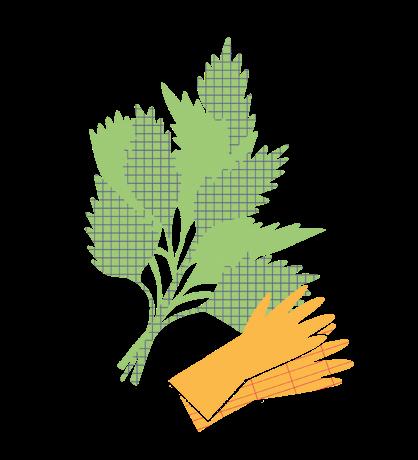
Most of us associate nettles - one of the best-known spontaneous plants - with memories of reddened hands and stinging calves: in fact, the main characteristic of the bright green plant is its sting, which is uncoincidentally also in the name. In fact, the etymology (of its Italian name Ortica ed.) refers to the Latin ùrere, to burn, and tactus, touch, leaving little room for the imagination. It is a resin that makes contact with the skin memorable. It is contained in tiny and very fragile spheres found on the hair that covers the foliage: at the slightest contact, it is released. For those passionate about botany, it is good to know that the level of irritability is different depending on the variety of nettle: so if contact with dioecious nettle (species in which the male and female flowers are on different plants) stings, that with the monoecious nettle does so more (male and female flowers on the same plant). Even more fearsome are the urentissima (island of Java) and the ferox (New Zealand) capable of causing very violent reactions. The collection of spontaneous vegetation
always deserves special attention but, in this specific case, instructions are extremely useful. Generally, it is the newest shoots that are harvested: it is therefore better to have a pair of gloves, scissors and a basket. It is ideal to choose mountain nettles or those grown in soils far from pollution. The right season for harvesting is spring, before the stems harden. The period in which its active ingredients are at their most powerful is the month of April, which is also when the plant gives its best in the kitchen. Before tasting some
40
recipes, it is worth remembering the many qualities in the herbal and phytotherapeutic fields, qualities known since ancient times. Among the writings that underline its virtues, in the words of Castor Durante, who in his "Herbario Nuovo" (1585), underlines that the nettle "is such a well-known plant that everyone knows it until the dark night” and is endowed with a very large number of “inside virtues” and “outside virtues”. In fact, it is known for its diuretic, purifying, anti-rheumatic, anti-haemorrhagic, hypoglycemic and curative properties for respiratory and throat diseases. According to Galenic medicine and the theory of humours, nettles have a dry temperament and one of the greatest Italian botanists,

Pietro Andrea Mattioli, who wrote one of the most beautiful herbariums ever in the 16th century, expresses himself on the same wavelength. In fact, Mattioli writes that the nettle "heals cancerous ulcers, and all those where it is necessary to dry without any stinging: because, being thin and dry in its parts, however, it is not so warm that it can sting", marking one of the typical features of the knowledge of the time, the contamination between medicine and phytotherapy. In the kitchen, the first secret to know is to handle it with care even after harvesting, therefore during the washing and cleaning phases. The stinging power of the leaves runs out after about 12 hours, or less if the plant is left to soak in water for a few hours. Nettle offers its most healthy properties when consumed fresh and raw. In this case, if the idea is to add the leaves to a mixed salad, it is good that they are kept in the fridge, wrapped in absorbent paper, where they can stay even one or two days. If a salad is certainly a hymn to the season of early fruits, there is

41 THE ULTIMATE FLOUR-INGREDIENT GUIDE SLICES/09 NETTLE
BY CATERINA VIANELLO
no doubt that nettle leaves can give greater satisfaction in cooking. Not much has changed since the Middle Ages: if there are indications in the cookbooks for dishes using the leaves, which are very rich in chlorophyll, as colorants in cakes and tortelli or for fillings, then today the leaves ( the young ones) reveal a remarkable versatility after being blanched and squeezed, allowing the nettle to appear across the entire menu, from appetizers to main courses. Risottos, soups and purees (perhaps with the addition of potatoes and barley), filling for tortelli, cannelloni and ravioli or colouring of the sheet of fresh pasta; and again to enrich omelettes, savoury pies, or simply blanched, sautéed in a pan with lard or bacon and garlic. And then again as a pesto, just like that of basil, with garlic, oil, pine nuts, Parmesan and salt, perhaps adding a little lemon juice.

Finally, lovers of boiled meat can replace the classic parsley-based green sauce with a new nettle-based ver sion. And on pizza? Added as a condiment or transformed into a cream, the leaves will certainly give a chromatic verve and flavour to the other ingredients, making the pizza that hosts them fully part of the category of "seasonal pizzas". When dried, the leaves can be transformed into a highly purifying infusion. As a final note, it is worth remembering how in the countryside nettles were used to feed animals: the leaves were in fact one of the main ingredients of "paston pai ochi", the feed for geese and hens, to which cornmeal and water were then added. Again, Castor Durante recalls how "the hens will lay eggs all winter long by giving them dry nettle in their food", confirming that nattles increased the production of hen's eggs and improved their colour. The same for cattle: not only did it increase milk production and make higher in fat, but it also helped make the butter yellower.

42
C M Y CM MY CY CMY K
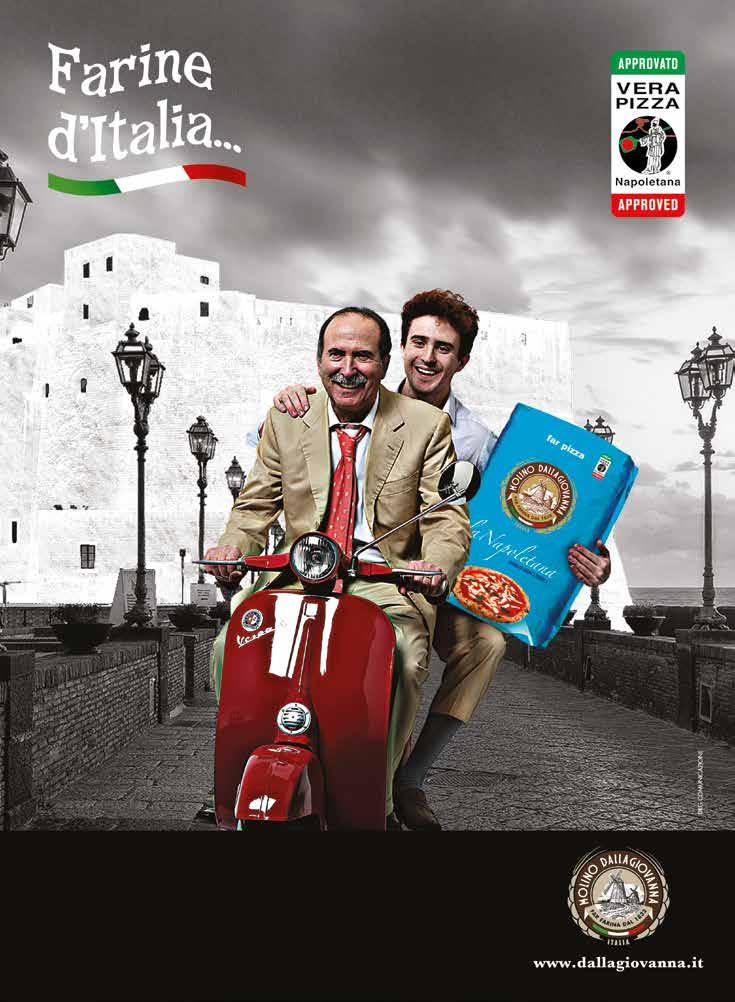

"Where are you off to without your pineapple?"
Semi-serious story of the loving relationship between pineapple and pizza

So, do you put your pineapple raw or cooked on your pizza? Ok, if you are still reading us after this opening, it means that you are a fan of this magazine so you should be rewarded. A few years ago, in 2017, the declaration of the president of Iceland that he wanted to ban the use of pineapple on pizza caused a sensation. The famous star chef Gordon Ramsay, the father of all "Kitchen Nightmares", imme-
diately lined up alongside him. However, two years later, in 2019, the genius Franco Pepe created AnaNascosta, where the slice of pineapple (natural) is wrapped in raw ham placed inside a fried cone with melted Grana Padano PDO and liquorice powder and thus won the "Dish of the Year 2019" award at the "Identità Golose" event in Milan. Perhaps driven by Franco's success, others pricked up their ears and two professionals like Simone Lombardi (Milanese of Mexican origin) and Pier Daniele Seu gave life to some splendid creations with this famous "tropical" fruit. However, it must be said that pineapple pizza has been on the scene since at least 1962 and bears the name of Hawaiian pizza.
44
BY THE EDITORIAL STAFF
They say it was invented by the Canadian Sam Panopoulos, originally from Greece, at "The Satellite" restaurant in ChathamKent, Ontario. According to Panopulos, in the 1960s pizza was still an unknown product in Canada and, after having tasted American pizza, he decided to re-propose it in his own restaurant, adding pineapple in syrup. Apparently, it wasn't meant to be a provocation or a marketing experiment,

45 THE ULTIMATE FLOUR-INGREDIENT GUIDE SLICES/09 PINEAPPLE AND PIZZA
as Panopulos told the BBC: "We added pineapple to the pizza just for fun, to see what it would taste like. The sweetness of the pineapple and the flavour of the ham created a pleasant contrast". However, the presence of pineapple in "savoury" cuisine was nothing new as Czech cuisine already featured recipes with pineapple and Prague ham but, more generally, sweet and sour cuisine had been known since the European Renaissance period. However, the recipe was very successful and spread all over the world. According to the analysis by Alessandro Pirollo in an article for La cucina italiana: "It was probably the criticisms that decreed its success, which prompted the most curious to taste it: after the initial uncertainty, everyone went crazy for the sweet-savoury combination and pineapple pizza began to travel to the United States" an interesting revelation by Pirollo himself. Finally, a curious fact. If you are not daredevils but rather "tested chemists", you can delight in using pineapple in the dough, as recommended by chef Francisco Goya and gastronome Nathan Myrhvold in Modernist Bread, the complete work on bread "made in USA". In fact, the two passionate authors recom mend using between 0.1% and 0.5% (of the total dough) fresh pineapple juice (or 0.3% papaya juice, but that's another story) because pineapple contains proteases, i.e. a class of enzymes that can denature proteins (including gluten), increas ing entropy, i.e. the amount of heat exchanged. Basically, technical
stuff. But that make us understand how beautiful and varied the world of pizza is. Even with pineapple. The Canadian pizza chef sold his place in the 80s and never patented the Hawaiian pizza, which today can be found on the menus of pizzerias all over the world. Without taking anything from Panopulos, to be honest, some people believe that Hawaiian pizza is a variant of the Hawaiian toast (an open slice of toast with cheese, ham, pineapple and maraschino cherry), created in 1955 by the first TV chef in Germany: Clemens Wilmenrod. Pineapple pizza (obviously arranged in slices - in syrup - after cooking the pizza) has therefore been generating fervent debates for over 50 years: according to a 1999 market survey, Hawaiian pizza was the most popular in Australia with over 15% of orders and in 2015 Just Eat magazine defined it as the most widespread on menus. Yet, in 2016, in the United States it was listed by a survey as one of the three least favorite toppings by consumers after anchovies and mushrooms, although at the same time it was also the eighth most popular type. It is no coincidence that since then we have returned to talking about pizza with pineapple: is it perhaps thanks to the multinationals that produce it?

46
BY
THE EDITORIAL STAFF
Whatever you do, just put your art in it. We’ll take care of the rest.



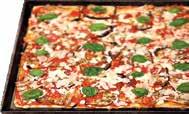

PIZZERIA? RESTAURANT? BAKERY?
GRETA
13 speeds dough mixer with energy saving function. For a more oxygenated and hydrated dough.
info@gaminternational.it www.gaminternational.it ® a member of MINERVA GROUP ®
KING The only electric pizza oven in the world cooking like a wood-burning oven. AZZURRO BAKERY The high performance and versatile oven ideal for small bakeries and restaurants.
BY CATERINA VIANELLO
Sausage and salami: history and use in cooking
Sausages and salami have been part of the gastronomic tradition of our country for centuries. The origin is common and refers to the use of residual meat deriving from the processing of more valuable cuts. To understand how ancient the art of making sausages and working meat is, we need to go back to the time of the Etruscans and Romans, look at the meeting of the Roman world with the Germanic one and then move on to one of the characteristic features of our country: typicality and differentiation existing between regions, geographical areas within regions, cities and small villages, each with a different tradition. But let's go in order.

Slices/
48
In Roman times, cured meats were called insicia (a term that refers to the operation of bagging meat) or botulus. It is only in the late Latin period that the term salumen begins to make headway, which however at the beginning indicates all foods processed with salt and which only centuries later will become exclusively referred to sausages and seasoned pork. With the decline of Rome and the arrival of the barbarian populations, even the gastronomic customs changed: thanks to the Longobards, different traditions progressively spread, including that of the processing of meat, especially pork. Areas more suited to the art of charcuterie begin to emerge, which coincide with the territories in which the presence of the Lombards is more marked. The first places of processing were convents and grange, ante litteram farms, which became spaces for collecting pork from the surrounding countryside. If the term still used to indicate salami is salumen, without specific distinctions, after the year 1000, following an ever-increasing consumption not only of pork but also of northern fish, different words had to be used to distinguish

the products: it was then that salamem appears, flanked by salacca, which however is not yet exclusive to the product. The "salamems" were sold by the "Lardaroli", whose business became, like many others, a corporation: the lardaroli then defined rules for the production and characteristics of the product, which progressively ends up differentiating itself according to the geographical area, outlining a real territorial characterisation of the recipes, which will gradually define the local typicality, the true strength of the Italian tradition. A different taste is also slowly emerging, with the North preferring flavours that tend to be sweeter and the South looking towards more decisive flavours. In the following centuries the success of cured meats grew and in the Renaissance we witnessed their definitive affirmation: their appearance at court and on the rich tables of princes and nobles was a sign of a true and proper consecration. At the end of the 16th century, in the manual "Trinciante" by Vincenzo Cervio, the noun "salami" appears for the first time and the name " salumiere" is established for the craftsman who works pork. Instead, the medieval "lardarolo" disappears and the terms "norcino" and "norcineria" remain in Central and Southern Italy. The production of salami becomes increasingly widespread, transversally appreciated and detached from the need to recover less noble cuts, or to preserve in salt for a long time: salami

SLICES/09 SAUSAGES AND SALAMI
49
BY CATERINA VIANELLO
becomes a matter of taste and specificity, with terms and denominations that soon become known, such as Milano salami or Hungarian salami or Napoli salami. If the affirmation of an industrial production process has multiplied and made the tasting possibilities accessible, the territorial element is still a winner, with small niche productions that deserve to be known and valued. Differences therefore remain the strong point of the Italian tradition: even if the processing and production phases are similar (shredding, mixing with salt and herbs, bagging and maturing are common moments), the art determines very different flavours. In fact, we have more than 100 recognized traditional salamis: origin of the meat, production area, type of cut used, type of grain, types of spices used (garlic, chilli pepper, fennel seeds, peppercorns, juniper), quantity and quality of fat, duration and maturing conditions, shape and size, smoking, mold... each of these elements contributes to returning a different result. If from north to south of the peninsula you are spoiled for choice – Lombardy has Brianza (PDO), Cremona (PGI, Lombardy) and
Salame di Varzi (PDO), in Emilia Romagna Felino (PGI) and Piacentino (PDO), in Sicily that of S. Angelo (PGI) – the advice, to make the best use of salami on pizza is to add it at the right time, so that the heat does not dry out the meat. Deserving of mention are the salami of Naples, with a fine grain, elongated cylindrical shape, external surface of a deep red colour, compact and non-elastic consistency, typical smoky smell, sweet and characteristic smoked flavour; the Tuscan finocchiona, pink in colour and whose strong point is its spiciness; the salame felino, the pride of the Parma area, with a ruby red color and a sweet and delicate taste. For spicy lovers, it is impossible not to mention

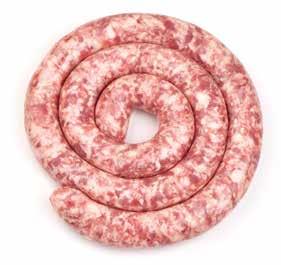
50
the Calabrian 'nduja, a unique "salami" in terms of texture and flavour. Sausage is similar in use but more versatile on pizza, as it cooks well by only partially altering its flavour, and can be used fresh (cooking it in the oven for the cooking time of the pizza), crumbled ( so as to release its fat thus adding flavour) or, if seasoned and very tasty, added in the last few minutes of cooking. It is also widespread from north to south (and with different names: luganega, salamella, salamina…), and finds its origin in the Roman world. The first historical testimony is that of the Roman historian Marco Terenzio Varrone, who attributes its invention to the Lucanians:
SALAMELLA: originally from Lombardy, it is a pure pork sausage, for the preparation of which only bacon and shoulder are used. The meats are flavored with a blend of spices and stuffed into mutton casings.
KNIFE POINT SAUSAGE: the regions with the strongest vocation are those of Southern Italy, in particular Campania, Calabria and Sicily. It is a coarse-grained sausage obtained by dicing parts of the pig such as shoulder, belly, leg and lard into cubes. These are cuts that, if minced, would be ruined both in terms of texture and taste with the heat given off by the machine. That's the reason behind the knife.
TUSCAN SAUSAGE: soft, rouned, made using pork shoulder and leg and flavored with garlic, black pepper, and also thyme and rosemary, it is appreciated for its balanced flavour.
It is generally produced by filling a natural casing with a mixture of lean parts (for example the shoulder) and fat parts (bacon) cut into cubes (or minced) and mixed with salt. Spices are then added to this mixture. Although it is practically impossible to draw an atlas of regional varieties (sweet, hot, spicy, smoked), a distinction can be attempted.
LUGANEGA: belongs to the Venetian, Lombard and Trentino culinary tradition, where it is recognized as a PAT. It is generally made up of pork, black pepper and garlic. There are variants with sheep and horse meat.
Though every region of Italy deserves to be valued for the variety of sausage typical of the area, we can still mention some ever valid combinations and some more unusual proposals. Among the best combinations are that between sausage and friarelli (the sprouts in the softest part of turnip tops), that between sausage and potatoes (perfect for the cold season), that with sausage and gorgonzola (for palates that love intense combinations), that of sausage with pumpkin and sausage with courgettes. For lovers of local specialties, it is worth mentioning some gourmet proposals: this is the case of pizza with Caserta black pork sausage, Agerola provola and yellow and red curly Neapolitan papaccella peppers, or that with Casentino gray wild pig sausage with potatoes.
THE ULTIMATE FLOUR-INGREDIENT GUIDE SLICES/09 SAUSAGES AND SALAMI
They call lucanica a meat stuffed in casings, because our soldiers learned how to prepare it from the Lucanians.
51
BY GIUSY FERRAINA
Pizza chef from the countryside, pizza chef of change

52 Slices/
Who is Giulia Vicini, the nineteen- year-old winner of the "sustainability" award at the Pizza World Championship?

In the thirtieth anniversary edition of the World Pizza Championship, there was a lot of talk about sustainability and sustainable pizza: this is a recurring theme which might seem to be trendy, or a question of marketing but which could open up a "necessary" path in this sector. We have seen the seed sprout with the winner of the “Pizza of Change” Special Prize: Giulia Vicini, 19 years old, attends a Specialized Technical Institute of Chemistry by day with the aim of taking a degree in chemical engineering and from 5 pm in the evening she puts her long blond hair in a hat and works on doughs and toppings in her restaurant "Giuly Pizza" in Castelli Calepio (Bg). When she is not studying or working, she runs off to Trentino to work as a volunteer on an organic farm. From the picture we have just painted, Giulia is quite untypical for a girl of her age: she almost sounds like an alien when she speaks but, from her voice and the emotion she puts into telling you about her life, it is immediately clear that she likes it: it's her world and it's a world where she lives well, because she takes care of it (and maybe we should do the same). We met Giulia Vicini during the World Pizza Championship and we saw her on the podium for the three best classic pizzas but - more importantly - she was the absolute winner of the first edition of the "Pizza of Change" sustainability award, organised and wanted in the event by Riccardo Agugiaro of Molini Agugiaro & Figna and by Massimo Puggina, editorial director of Pizza e Pasta Italiana.
“It was my first time in the Championship and I couldn't imagine all this.
When they told me about third place and the sustainability award, I could hardly believe it: it was a real shock. At that moment I could not understand what was happening, I felt too many emotions at the same time. And the greatest satisfaction and joy was that of the Pizza for Change award.
When I signed up for the competition, my goal was to present my "sustainable pizza" and win this prize. Nothing else interested me, because that trophy fully represented the work done and that which my partner Giulia Zanni and I believe in and try to commit to improving every day".
PIZZA CHEF FROM THE COUNTRYSIDE, PIZZA CHEF OF CHANGE SLICES/09 THE ULTIMATE FLOUR-INGREDIENT GUIDE
53
I still remember Giulia’s smile during the championship days in Parma, her bright eyes and above all a great enthusiasm in talking about her work and the pizza she brought to the competition. An enthusiasm that embodied passion, the conviction of the right choice and also the subtle fear of having done something wrong or, better, of not being understood in the choice of her path as a pizza chef... but also as an inhabitant of planet Earth.

Her pizza with the symbolic name "Terra-Terra" was meticulously studied, as she herself tells us:
“The idea of Terra-Terra was born by bringing together the two Giulias who are partners and friends, our love for the land, the passion we have for nature. That's why we wanted an entirely organic pizza, which uses only organic products or from Slow Food Presidia, such as Bagoss, a cheese produced by a few cheesemakers in Bagolino, not far from my house. We chose an organic flour, ground 15 days before, to have aroma and fragrance, seasonal garden cress and asparagus, toasted almonds and always organic honey; I also got the milk for the fondue from an organic farm in my area. And, the icing on the cake, I used my own oil from olives I picked myself. For the presentation dish we also decided to promote a local craftsman, Clay Lab, who created an ad hoc dish for our pizza.”

54
Slices/ BY GIUSY FERRAINA
THE ORIGINAL PINSA ROMANA



High hydration
Exceptional lightness
Unique crunchiness
Utmost digestibility


THE FLOURS THE BASES
High quality for a genuine success
www.dimarco.it
BY GIUSY FERRAINA

The choice of products was then followed by days of testing the dough, assembling the ingredients, balancing the flavours and obviously the tastings. Every detail studied with meticulousness to reach the only goal: to win the Pizza for Change award and demonstrate that a sustainable pizza can be made, that a pizza like this exists and wants and must be the pizza of the future. Giulia is a daughter of art: her father has always made pizza and he was the teacher of his "little girl", who literally grew up among sacks of flour and balls of dough. At first it was a game; then, as soon as she could, she began to spread the pizza behind the counter and experiment. And, as history teaches us, the students surpass the masters. So, Giulia has a very clear picture of what she wants despite being so young: to use organic and quality products, those of small producers, those
that you fall in love with when you taste them because their flavour explodes in your mouth; she wants a healthy, seasonal pizza truly full of flavour. In a nutshell, she wants a sustainable pizza, where this overused adjective means a pizza that respects the environment and nature and that conveys to those who eat it what goodness is. And every day she is committed to looking for new things, making new combinations and thinking up new recipes to enrich her line of special pizzas, which are written on the blackboard in the dining room, while she leaves the task of making the classic pizzas to her father. For her young age, Giulia Vicini is the example of a generation attentive to environmental values, the ecosystem, healthy and good food and with her "championship adventure" she is telling us that the path to sustainability in pizzerias and in catering can be undertaken.
"Absolutely - she tells us with conviction - but it is not a simple thing: it requires commitment to first of all change one's life and consumption habits, in what we choose to buy and eat and then being able to apply them in the kitchen and knowing how to pass them on to others. It sometimes happens that my peers jokingly make fun of me: for them I am the pizza maker - peasant. Then, when they eat my pizza, they are amazed by the flavour, the real taste, the quality I seek and they understand the meaning of my life choices. My pizza speaks for me, it is an ambassador of my philosophy”.
56
Slices/


see Official Listing LISTED C US UL COMPONENT
GIUSY FERRAINA

There is a strong bond between Giulia and pizza, an almost symbiotic relationship.
“For me, pizza is home, everyday life. It's the thing I know how to do and perhaps the only thing I really know how to do, it's something that belongs to me and gives me security, I could hardly live without it. In the future - the distant future - I would like to make pizza with all ingredients produced on my farm; for the near future I think this is the real quality pizza: a genuine pizza that uses only good and right products”.
58 Slices/
BY
R RECIPES
I
INGREDIENTS:
Type 1 and type 2 flour of ancient grains
Bagoss 24 months
Organic milk
Organic asparagus
Organic garden cress
Gooseberry jam
Almonds
Parmesan Cheese
Olive oil
Organic chestnut honey
Turmeric
Beetroot juice
Terra - terra
TERRA TERRA PIZZA
Method
Wafer preparation: Grate the Parmesan cheese, make wafers in a pan and colour them by dipping them in beetroot juice or turmeric water
Fondue preparation: Grate the bagoss into the organic milk and mix over the heat until thickened
Preparation of asparagus cream: Boil the whole asparagus for 15 minutes, cut off and set aside the heads to use as a filling, blend the asparagus with the Parmesan and the oil
Garden cress preparation: Blanch the cress for a few minutes in a pan with a little oil
Almond preparation: Split the almonds and sauté them in the pan until toasted
1) spread our base once it has leavened
2) spread the bagoss and milk fondue
3) bake
Upon removal from oven:
1) Dot with asparagus cream

2) place the asparagus heads and the cress
3) add the wafers
4) sprinkle with almonds
5) drizzle a little honey
6) drip with gooseberry jam
7) a drop of oil
SLICES/09 59
E THE ULTIMATE FLOUR-INGREDIENT GUIDE
Cristian Tolu

THE PIZZA CHEF OF THE WORLD TO COME
“I have always been a dreamer. Ever since I was a child, I have always had the habit of setting myself important goals and behaving as if there were no limits. I believe I'm really determined and definitely quite charismatic."
Born in Cagliari in 1987, Cristian Toluwinner of the 2023 World Championship in the "Pizza a due" but also head of the best Pizza Team - is the undisputed "dominus" of pizza competitions in Italy and around the world. Cristian lived the first years of his life in a small village in southern Sardinia, Maracalagonis, known for the ancient confectionery tradition of which his maternal grandmother was one of the most famous experts of the area. "This - says Cristian - was a great fortune for me as it allowed me to be able to taste, prepare and experiment from an early age, knowing in detail what the fundamental raw materials of my tradition are, and making me passionate about good food ”. As a teenager, he moved to Quartu Sant'Elena, one of the renowned places in our national history
because it is the port from which the thousand red shirts led by Peppino Garibaldi set sail.
How and why do you get passionate about pizza?
I come from a family of very hard workers from which, thanks also to my mother, I immediately understand how important independence is. After completing my basic studies, I immediately enrolled in a training course at the Forte Village Resort where I managed to spend two years of boarding school in order to enter the kitchen. I think I was lucky, because this allowed me to study and immediately learn a trade that would then allow me to have the "independence" I dreamed of. Perhaps the engagement at an early age with my wife and the fact that my father was a highly experienced pizza chef are "responsible" for my estrangement from the stove due to the timetables
Slices/ 60 BY ANTONIO PUZZI
and the approach to the wood-burning oven. Thus, by combining what I liked to do, "cooking", with what has now become my greatest passion, I created a union between cooking and pizza.
Talking about pizza in Sardinia is not easy, but getting Italy and the world to talk about Sardinian pizza could seem like an impossible mission: how did you do it?

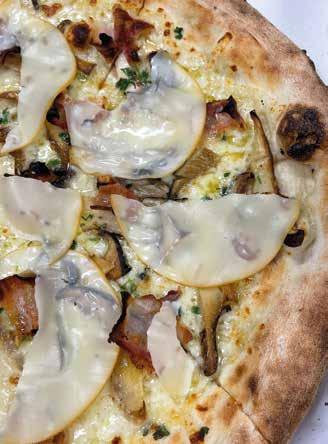
Sardinia boasts a great gastronomic tradition, especially as regards bread-making. It is quite easy to find good durum wheat bread almost everywhere, we have it almost in our DNA. I will always remember in my grandmother's house the bowl with "Su Xetti", the sourdough that she jealously guarded for leavened products and some types of desserts. The island, as per its geographical conformation, suffers from the great problem linked precisely to insularity. From an early age we have had the problem of travel: on the contrary, I wanted to exorcise this situation by taking advantage of it.
I come from a rather depopulated area, where doing something good is difficult but doing something excellent is almost impossible. So, it became a mission for me to be able to achieve all these results: my goal was to get the kids to understand that anything can be achieved in life: "only" study, devotion and lots and lots of work are needed. After that, everything is possible. You just have to really want it. Today, having achieved so many goals is a source of pride for my people and above all for my children who regularly support me and prepare their lucky drawings for me. It is the true meaning of my challenge: to leave a mark and give hope.
THE ULTIMATE FLOUR-INGREDIENT GUIDE SLICES/09
THE PIZZA CHEF OF THE WORLD TO COME
62 Why does someone who "has won everything" like you participate in the World Pizza Championship?
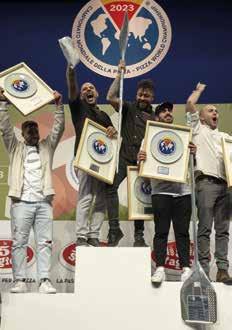
The World Pizza Championship in Parma is truly the Olympus of competitions in the world of pizza. Only once you win in Parma can you call yourself World Champion. I had one goal, which was to get on the podium with my Team: the Cerevisiae Team, a group of guys who trained precisely in the competitions we participated in. We succeeded. Parma is the most important stage for everyone, not just for me. All the colleagues with whom I am in regular contact say so. Being able to climb to the top of the podium twice in one day was a dream. I cried for two days straight. I still can’t believe it.
shared by more people and, in general, this is the case all over the world. Pizza is social redemption, thinking of all the neighborhoods in the suburbs where young people find work in restaurants and, more precisely, in pizzerias. Pizza is love because - let's face it - if you don't love it, you can't do this job. Pizza is union because it unites tradition with innovation, it unites peoples, it unites intelligent people. In short, pizza is the perfect dish.
What is pizza for you?
This is a good question. I think pizza is the symbol of sharing. It is sliced to be
Your reflections are really beautiful, I would say "moving". At this point, however, you "must" tell me what "your" pizza is, the one that tells your story. I think this is the hardest question. When I think about the ingredients, I'm spoiled for choice. Over time, I have had the chance to dedicate various pizzas to all the members of my family: my grandmother, my mother, my children… Now that I think about it, I still haven't dedicated one to my wife but now the right time has come, also because if it weren't for her, I would be able to do very little. However, coming to the answer, in terms of category, I think it is the Roman shovel. Let's just say that it's the one that fascinates me the most. Although I have mostly worked with classic pizza, pizza on a shovel is the one that intrigues me the most. I think it's the most versatile, also because it lends itself more to the use of a mix of cereals: we can make various blends, we can insert seeds, raise hydration, fill it in the middle or even make it "on the plate". Let's say it's the one that needs the most technique, but it's also the most versatile.
Slices/ BY ANTONIO PUZZI





As always, you know how to amaze us. So, surprise us all the way: what will be the pizza of the future?

The pizza of the future definitely has to reverse the course. It must be a pizza that selects raw materials in terms of efficiency and circular economy, first and foremost. There is a lot of talk about local produce, waste reduction, etc. I think it's time to actually do it. In my company, in my small way, I try to identify local producers and address them only. With the serious crisis we are experiencing, the only way is to look to the future with a product that is more refined and that manages to reduce waste. We have to improve the transformation of raw materials by limiting costs and increasing customer care. The main objective is to keep the Italian agri-food sector active: we have an immense fortune, an incredible selection of raw materials, we just need to remember it more often. It is possible to preserve all of this, you just need more commitment and a great desire to do well. We have a great responsibility, which is to create a better future.

Slices/ BY ANTONIO PUZZI RECIPES 64
E
R
DOUGH INGREDIENTS:
850gr (30 oz) Soft Wheat Flour “0”
150gr (5 1/3 oz) Artemis rice
Drunk scallop I
DRUNK SCALLOP
800ml (28.15 UK fl oz / 27.05 US fl oz) Water
26gr (9/10 oz) Salt
6gr (1/5 oz) Fresh Yeast
3gr (1/10 oz) Dried Sourdough
winning recipe of the Pizza a Due at the last edition of the World Pizza Championship. The dough is a creation by Raffaele di Stasio.
Method
FILLING INGREDIENTS:
Lard from Colonnata
Fresh spinach in foil
Scallops deglazed with brandy
Scallop Coral and Lime Mayonnaise
Dry bread aromatised with coffee
For the dough: crumble the fresh yeast into the flour, add the sourdough and start kneading with 700 ml (24.6 UK fl oz / 23.7 US fl oz) of water for about 10 minutes, after which we will have an initial formation of gluten. Gradually add the remaining 100 g (3.52 UK fl oz / 3.38 US fl oz) of water and, almost at the end, the salt. Once we have formed our dough, let it rest for 10 minutes. Fold over twice every 15 minutes and place covered in the fridge. The following day, proceed with cutting the loaves, let them rise for another 4 hours and then proceed with spreading and cooking. Initially cook in boiling oil (180 °C / 356 °F) and once cooked, finish drying in a static oven for 2/3 minutes. Divide into 4 parts and fill.
For the filling: cook the spinach en papillote, deglaze the scallops with the brandy and the corals, the eggs and the lime, prepare an express mayonnaise. Take care to let the bread dry and leave it for a couple of hours to soak in the coffee, let it dry and crumble. If necessary, once chopped, it can also be toasted in a pan.
PFill in the following order: Colonnata lard, baby spinach, scallop strips, mayonnaise and coffee bread crumble.
Enjoy your meal!

SLICES/09 65
E
E
THE ULTIMATE FLOUR-INGREDIENT GUIDE
PIZZA E PASTA ITALIANA
Monthly food and food culture
magazine
Published by PIZZA NEW S.p.A. With permission of the court of Venice
n. 1019 del 02/04/1990
n.09, July, 2023
English Issue
Repertorio ROC n. 5768
EDITORIAL DIRECTOR
Massimo Puggina
EDITOR
Antonio Puzzi
EDITORIAL ASSISTANT
Lorella Di Vilio
ADVERTISING
Caterina Orlandi
EDITING OFFICE
30021 CAORLE (Venezia) via Sansonessa, 49 Tel. +39 0421 212348
Fax +39 0421 83178
E-mail:

redazione@pizzaepastaitaliana.it follow us

www.pizzaepastaitaliana.it
GRAPHIC DESIGN
Manuel Rigo, Paola Dus — Mediagraf lab
ILLUSTRATIONS by Giulia Serafin
PRINTING OFFICE MEDIAGRAF SpA
Noventa Padovana (Pd) - ITALY
EDITORIAL AND TECHNICAL COMMITTEE
Marisa Cammarano, Alfonso Del Forno, Caterina Orlandi, Caterina Vianello.
ASSOCIATED WITH THE ITALIAN UNION FOR PERIODICAL PRESS FOR


ADVERTISING OF FOREIGN MAGAZINES
ITALIA Pizza e Pasta Italiana
U.S.A. Pizza Today, P.M.Q. –
TEL +39 0421 212348
FAX +39 0421 83178
66 COLOPHON
Slices/

Since 1990, Pizza e Pasta Italiana has been the Italian magazine of reference for professionals working in the pizza sector. As the organiser of international events such as the Pizza World Championship, Pizza e Pasta Italiana magazine tells the story of pizza over time, in Italy and in the world, through scientific articles, interviews with professionals, thematic insights on toppings, ingredients and specialities, processing techniques and new trends, with a constant spirit of service towards the restaurateur.
Slices is a print and digital publishing project that continues to grow by looking into some of the basic raw materials to make pizza to perfection. "Slices" of culture for professionals only, offering them a practical and immediate tool to progressively contribute to spreading knowledge of raw materials, processing techniques, technologies and the most suitable tools to prepare, with passion and love, one of the most loved dishes in the world.
Third Year:
/The ultimate flour-ingredient guide - Part 09

Upcoming publications:
/Pizza Equipment Essentials
Part 10
www.pizzaepastaitaliana.it






















 BY MARISA CAMMARANO
BY MARISA CAMMARANO


 BY MARISA CAMMARANO
BY MARISA CAMMARANO




 BY GIUSY FERRAINA
BY GIUSY FERRAINA





 ▷ "Trapizzino" by Stefano Callegari
▷ "Trapizzino" by Stefano Callegari














































































